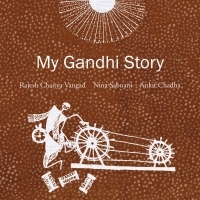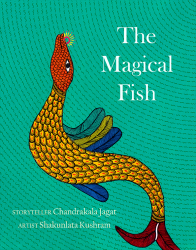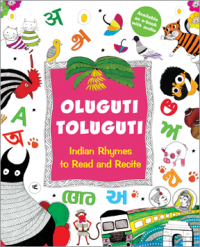Interview with Radhika Menon, founder & managing editor of Tulika Books, India.
Sohini Basak: How did Tulika start out?
Radhika Menon: When we set up Tulika Publishers in 1996, we wanted to create Indian books that were as good as the best books anywhere. No, not “just as good as.” We want to give the children supremely good books and we wanted these books to be right in the Indian context. Our own generation had been fed books from the West, and had been taught to keep away from the more didactic, mass-produced Indian books. Good books, we assumed, came from elsewhere, usually from England!
We needed to reflect a contemporary Indian sensibility. But the contemporary Indian reality was vast, varied, and multilingual. It was clear to us that we would have to publish in as many of the Indian languages as possible.
Today we publish picture books in nine languages simultaneously—English, Hindi, Tamil, Malayalam, Kannada, Telugu, Marathi, Gujarati and Bengali. We also do bilingual books—English paired with each of the other eight languages. Some of the books for older children are in English alone and they too reflect a contemporary “Indianness” in their perspective, and in their very feel and look.
SB: What have some of your recent successes been?
RM: My Gandhi Story is a picture book for the 5+ age group, and it has, of course, been published in nine languages. An unusual collaboration between a Warli artist, an animation filmmaker and a storyteller has resulted in a book that reads well and looks good. It has also sold very well, and that never hurts.

The Magical Fish (ages 6+, 9 languages) is the coming together of a storyteller and an artist, who are both from the Gond tribe in central India. The storyteller, Chandrakala Jagat, a day labourer used to building houses and digging ponds, injects much of her own strength and determination into the character of the old woman in the story. According to a recent review, “There is something fantastic about the way that the art and words of this story weave in and out of each other with such ease and simplicity….”

Two recent books, Hambreelmai’s Loom (a folk tale from Arunachal Pradesh) and Race of the Rivers (a folk tale from Meghalaya) are the first-ever picture books in the Mishmi and Khasi languages, respectively, both from tribal northeastern India. They’ve also been published in the nine languages we normally do.
Even if it is not recent, I would like to include our multilingual book Oluguti Toluguti: Rhymes to Read and Recite. This is a collection of 54 rhymes drawn from 18 Indian languages (including lesser known ones like Konkani, Lotha, Mewari and Mizo) that offers a culturally rich alternative to the English nursery rhymes many Indian children have grown up with for many years. The rhymes are presented in the original language, with transliterations in Roman and Devanagari (Hindi) for easier access, and are also adapted into English, keeping to the rhythms of the original.

SB: Tulika specializes in picture books, and the concept of bilingual books for children is most intriguing. Does the added medium of illustration help in translation from one language to another when you’re creating these bilingual books?
RM: The illustrations make the books as exciting as any other picture book—the “language learning” element becomes secondary, even if parents and teachers pick it up for teaching purposes. The pictures work as visual clues to the understanding of words in a new language. The visuals in the bilingual books range from rich folk and contemporary styles, to photographs and graphics. They add another dimension to the bilingual texts and make the learning of a new language less intimidating.
SB: In India, there still seems to be an unpleasant divide between children studying in English-medium schools and those studying in schools which instruct in our regional languages. As an educator and publisher, do you see this divide affecting the reading habits of children, or even their parents, especially while choosing books by languages?
RM: There is a divide between children studying in English-medium schools and those studying in schools that teach in one of our regional languages. While the divide is created by economic and social disparities between the children in the two kinds of schools, it is the language of instruction that deepens the divide. And there’s an irony here because surely the purpose of language is to communicate with each other, not the reverse. English has become the language of the privileged and is associated with power and money and all the trappings that come with it. English schools which are private fee-paying schools have better financial resources and relatively better facilities which include a library. This is by no means the norm and the libraries in many of these privileged schools are far from well-stocked. And often the choice of books and the library rules do nothing to interest children in books.
Just being an English-medium or a non-English-medium school, or being a rich or poor school doesn’t mean that the school has a good library or encourages reading. On the other hand, there are government schools with committed teachers and schools where NGOs run library programmes that successfully foster a love for books and reading among the children despite widely disparate reading levels. Poor reading habits have more to do with the attitudes of parents and teachers rather than with the medium of instruction.
And of course good books make all the difference. There is a gap in the quality of English language books and regional language books: in the writing, illustrations and production. This is not to say that there are no good books in the regional languages. But the pressure of making them available cheaply has meant that mass market books are favoured by publishers. This is where publishers like Tulika have made a difference.
We want Tulika books to go everywhere—and they do. Tulika books can be found in village libraries, large city schools, government schools, and in libraries all over the world. Books that have won international awards are being read by children in remote corners of India. The same attention is given to content, design and production to the books in all the languages, so that for the first time Indian children, whatever their background, have access to quality books in a language they understand.
SB: What has been the impact of multilingual publishing on Tulika’s overall publishing programme?
RM: Our books have a unique flavor—call it a sensibility!—that sets them apart from other books. I think it comes from engaging with translations in several languages. Children’s publishing in the regional languages is often circumscribed by narrow cultural beliefs and biases about both the content and function of children’s books. Parochial attitudes narrow the space further. For the large part, the books are didactic and conventional.
Conversely, the good Indian books in English—there is a lot of mediocrity here too—have a dynamic cultural identity that is changing and evolving constantly. The style and perspective the authors of these books bring to their writing comes from a culturally unique “translated” sensibility. Dismissing them as being Western and rootless is to dismiss a growing generation of children who think and speak in English while their experience is rooted in an environment to which the regional language adheres. It’s there in their families, their neighbourhoods and in the films, songs, television programmes they listen to. To ignore English is also to ignore the needs of a large section of children aspiring to learn English as a language of empowerment.
As editors we do feel at a disadvantage sometimes because we are primarily English-speaking. On the other hand, engaging with narratives for children in English first and then in different languages at least forces us to open our minds and take in the perspectives and shades of meaning that other languages bring. While the author and the translators each see a book in one language only, our editorial decisions are influenced by seeing the book in all nine languages—starting with the title of the book! This creates the space for a body of literature for children that reflects the connectedness of regions, languages and cultures as well as their distinctive features. These, we believe, are books that provide passage from one culture to another. These are books against borders.
*****
Radhika Menon’s deep interest in children and their reading inspired her to set up Tulika Publishers in 1996. Today, books from Tulika, being published in nine different Indian languages—English, Hindi, Tamil, Malayalam, Telugu, Kannada, Marathi, Gujarati and Bangla—are regarded as the benchmark in children’s publishing in India. She passionately believes that translating across different languages gives voice and image to cultural diversity in a way that publishing in just one language does not—a philosophy that now defines Tulika. A hands-on publisher, she is closely involved with the visualizing, editing, designing and marketing of the books.
Sohini Basak is from Barrackpore, India, and is currently studying for a postgraduate degree in the UK. She was one of the winners of the inaugural RædLeaf India Poetry Prize and her work has appeared or is forthcoming in journals such as Paris Lit Up; Ambit; Litro. She manages English social media for Asymptote and has finally started a blog.

